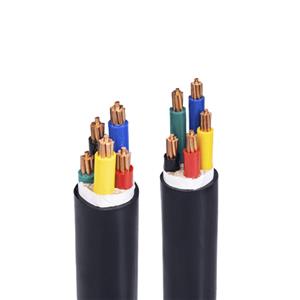Do you know the difference between wires and cables?
Wires are generally used as conductive metal wires that carry current. There are various forms such as solid, twisted or foil braided. According to the insulation condition, they can be divided into two categories: bare wires and insulated wires. Cables are insulated wires composed of one or more mutually insulated conductive cores placed in a sealed sheath. A protective covering layer can be added to the outside to transmit, distribute electrical energy or transmit electrical signals. The main difference between it and ordinary wires is that the cable size is larger and the structure is more complex. The difference between wires and cables is that the size of wires is generally smaller and the structure is simpler, but sometimes cables are also included in the category of wires in a broad sense.
Wire and cable manufacturers will give you a detailed explanation of the difference between wires and cables from the following perspectives. First of all, from the basic definition, wires are wires used to transmit current. They are usually composed of one or more mutually insulated conductors, with a small diameter and a relatively simple structure. Wires are mainly responsible for the transmission of electrical energy and are commonly used in low-voltage, low-power scenarios such as home lighting and electrical appliance connections. Cables are a combination of wires composed of one or more mutually insulated conductors placed in a sheath, and the structure is more complex. In addition to the conductor, the cable also includes an insulating layer, a protective layer (such as a sheath), etc., and sometimes may also include a shielding layer to enhance its anti-interference ability. Cables are suitable for power and signal transmission under high voltage, high current or specific environments, such as power transmission, communication networks, industrial control and other fields. From the perspective of structural composition, the structure of the wire is relatively simple, mainly consisting of a conductor and an insulating layer. The conductor material is usually copper or aluminum; the insulating layer is wrapped around the conductor to prevent current leakage and ensure safety in use. Common insulating materials include polyvinyl chloride. The structure of the cable is more complex and diverse. In addition to the conductor and insulating layer, it also includes a sheath, a shielding layer, a filler and an armor layer. The sheath is located outside the insulating layer to protect the cable from physical damage and environmental erosion. Common sheath materials include PVC, (PE), etc. In some cables, especially in situations where high anti-interference ability is required, a layer of metal braided mesh or foil is added outside the insulating layer as a shielding layer to reduce external electromagnetic interference. For cables that need to be buried or used in special environments, fillers may be added to maintain shape stability, or metal armor layers may be added to enhance mechanical strength and anti-rat bite capabilities.

In terms of application scenarios, wires and cables are also different. The application scenarios of wires are mostly concentrated in household appliance connections, indoor wiring, power cords for small devices, etc. For example, lighting lines, socket connection lines, power cords for TVs and refrigerators in the home, etc., all belong to the category of wires. The requirements for wires in these scenarios are mainly safe and reliable, easy to install and low cost. The application of cables is more extensive and complex, covering from high-voltage transmission lines in power systems to optical fiber cables in data communications, to professional fields such as industrial automation, rail transportation, and marine engineering. Cables can adapt to the needs of power and signal transmission in long distances, large capacities, and complex environments, such as submarine cables for transoceanic communications, mining cables for underground mining operations, and special cables that are resistant to high temperatures and corrosion.
In terms of performance characteristics, cables can carry higher voltages and currents due to their complex structure, and are suitable for long-distance, high-power transmission, while wires are more suitable for short-distance, low-power applications. The shielding layer design in the cable enables it to have better anti-interference ability during signal transmission, and is suitable for communication systems that require high-precision transmission. The sheath and armor design of the cable enable it to adapt to a wider range of environmental conditions, including extreme temperatures, humidity, corrosive gases, mechanical wear, etc. Both need to meet the corresponding safety standards, but the cable has more comprehensive protection measures in complex environments, such as higher flame retardancy and fire resistance, and is more suitable for use in public facilities and industrial sites.

Although wires and cables are both basic components for power and information transmission, they differ significantly in terms of structural complexity, application areas, performance characteristics, etc. Wires are suitable for connecting households and light electrical equipment due to their simplicity and economy, while cables play an irreplaceable role in large-scale power transmission, complex communication networks, and special industrial environments due to their strong current-carrying capacity, excellent anti-interference and wide adaptability.




